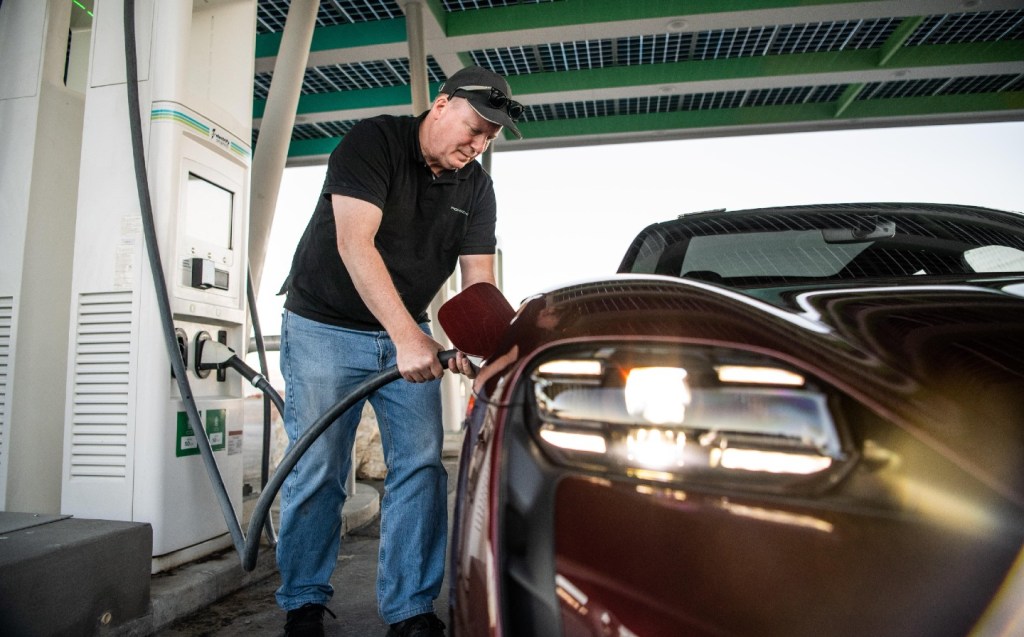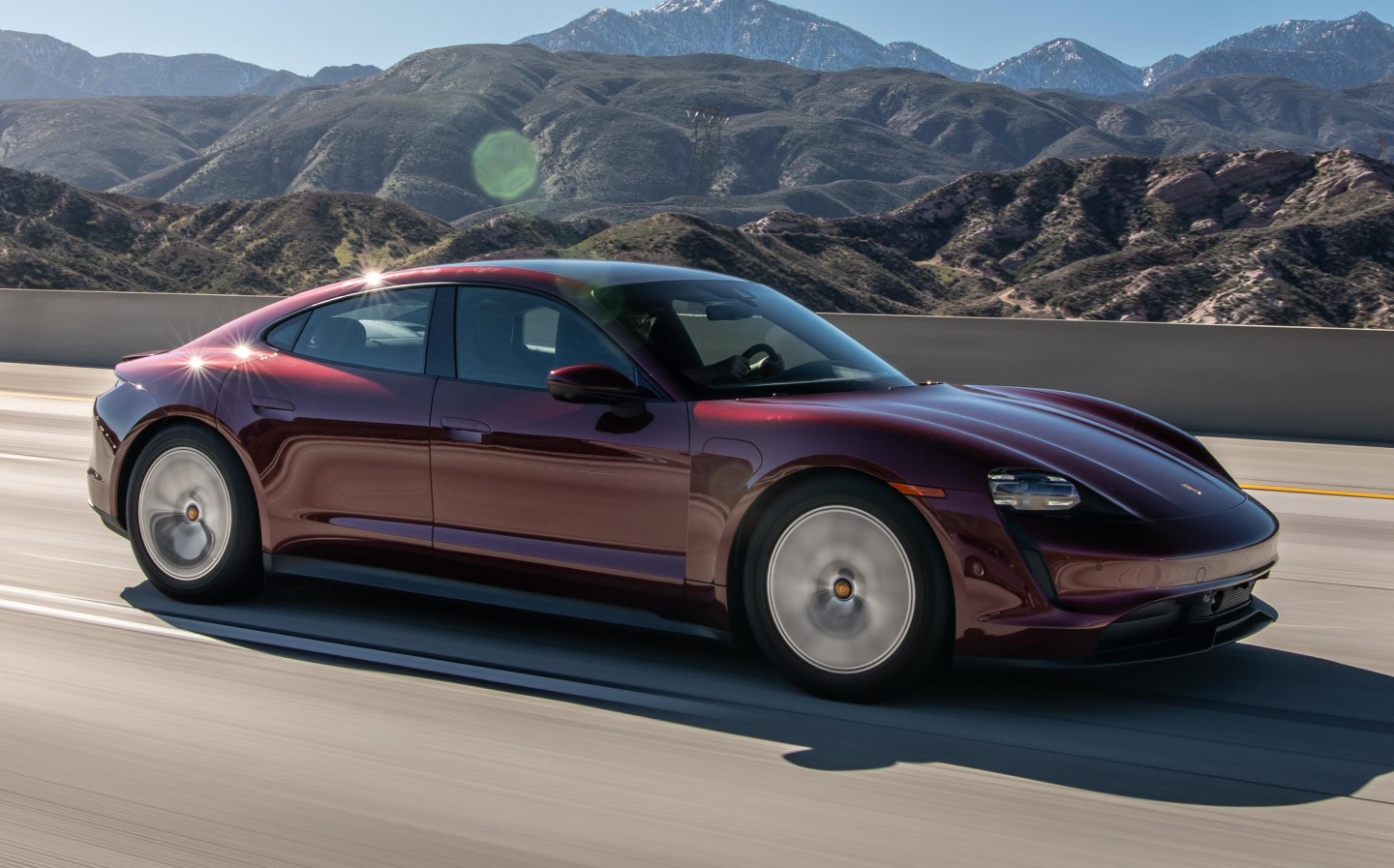This is how a man drove an electric Porsche 2,834 miles across America, charging for less than 2.5 hours
Cannonball Run recharged
AN AMERICAN “hypermiling” expert has revealed how he managed to set a new record for the shortest charging times while crossing the United States coast-to-coast in an electric car.
Interviewed in The Sunday Times Magazine, Wayne Gerdes recounted how he made the journey from New York to Los Angeles last November in an all-electric Porsche Taycan during which he spent just two hours and 26 minutes recharging — a massive improvement on the previous record of seven hours and ten minutes set last year using a Kia EV6.
Over the 2,834.5 miles covered, Gerdes stopped to recharge 18 times, spending just $76 (£56) on electricity, using a “little and often” approach to reduce the charging times and, on one occasion leaving a charger with a battery that was just 27% full.
He said that a battery is able to take a charge more quickly between 5% and 35%, so his approach involved not just keeping the charging level in that sweet spot, sometimes topping up for no more than six minutes, but driving with his shoes off too.
“You can feel the accelerator a little tighter, a little closer, a little finer if your feet don’t have a shoe on that foot pedal. I highly recommend it,” he said.
It was these “hypermiling” techniques — driving in such a way so as to eke out the maximum range from either a tank of fuel or a charged battery — that enabled Gerdes to sometimes double the Taycan’s official 225-mile range.

CREDIT: ROBIN TRAJANO
Both his own and the Taycan’s performance on the journey impressed Gerdes.
“I was planning [a total charging time of] four and a half hours. After a few trial runs I got it down and said OK, I think we can finish in three and a half hours. Then on the record run it was less than two and a half hours and I was, like, holy mackerel. You can feel my excitement even talking about it. I’ve broken a lot of Guinness World Records before, but I haven’t beaten the next guy by 300% and the guy before that by 500%. That’s just an outrageously great time.”
“I’ve set records in Volkswagen diesels, Kia hybrids, the [hydrogen-powered Toyota] Mirai — a number of different vehicles with different propulsion technologies,” he said.
“There I was driving all these slower, lower-performance vehicles to earn Guinness World Records and then all of a sudden, in the case of the Taycan, it’s a performance car with world-class acceleration.”
A former nuclear power plant operator, Gerdes, 59, is a veteran record-breaker and hypermiling practitioner even being credited with inventing the term back in 2004. He began hypermiling more than twenty years ago in response to the 9/11 attacks. Following the collapse of the Twin Towers, he vowed to come up with ways to reduce America’s dependence on foreign oil.
“That’s my premise and I’ve lived by it every day since then. We still import a lot more oil than we actually produce. A lot of that money goes to places where they don’t like us. I just thought, what can we do to lower our consumption? So hypermiling — I coined it.”
In the early days, he managed to squeeze a full 84mpg from his old Ford Ranger pickup whose official economy was just 20mpg. His highest figure, however, would eventually be the 180mpg teased from a Honda Insight hybrid.
While techniques for hypermiling in petrol- and diesel-powered cars such as removing roof racks, careful acceleration, ensuring tyres are correctly inflated and practising slipstreaming (following closely behind another vehicle on a motorway) are well-known, Gerdes has outlined a few EV-specific top tips to help drivers extract the maximum battery range from their cars.
Wayne Gerdes’ electric car hypermiling tips
- Use the car’s “range” mode or equivalent to get the most from the battery. This optimises the car’s settings, such as climate control and driving modes to ensure maximum efficiency and lower electrical consumption.
- Programme navigation for the shortest route between rapid chargers. Faster routes may be longer and less efficient than the shortest journey between chargers.
- Pre-condition battery en route to the charger. Pre-heating the battery before you reach a rapid charger enables the unit to deliver electrical charge at the highest possible rate immediately (225kW in the case of the Taycan). MAny new electric cars will do that automatically if you set the sat nav to take you to a rapid charger.
- Stay in the charging sweet spot. For the fastest charging, Gerdes says, allow the battery to deplete to less than 5% charge and top up to no more than 50%. The fuller a battery gets, the slower it will charge, so for those in a hurry keeping the charge level at the lower end of the scale can be more time efficient than topping up to 80% and above.
- Engage active cruise control. Though not available on all EVs, active cruise control helps to smooth out harsh acceleration or deceleration, reducing the higher electrical consumption associated with both.
Read the Sunday Times Magazine article at Times.co.uk
Tweet to @ST_Driving Follow @ST_Driving
Related articles
- If you liked this story about how Wayne Gerdes drove an electric Porsche 2,834 miles across America, charging for less than 2.5 hours, you might also like to read our track review of the Porsche Taycan GTS
- And check out what every car maker has planned in terms of new electric cars
- Want to know more about Lunaz’s Aston Martin DB6 electric conversion? Click here.
Latest articles
- Aston Martin Valkyrie AMR-LMH hypercar hits track ahead of 2025 Le Mans challenge
- Porsche has begun testing the electric Cayenne
- Cupra Leon 272 eHybrid 2024 review: Bigger battery, better tech … but is it a Cupra?
- Porsche 911 GTS 2024 review: Hybrid heresy or more Stuttgart genius?
- Extended test: 2023 Vauxhall Astra Sports Tourer GS PHEV





